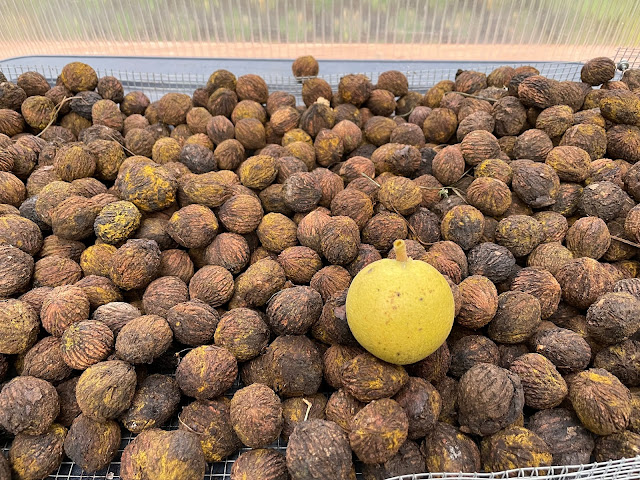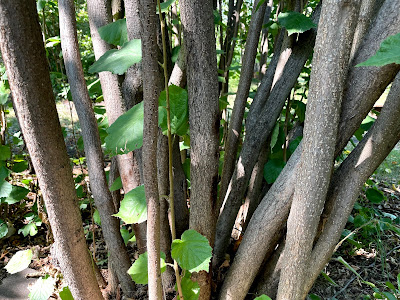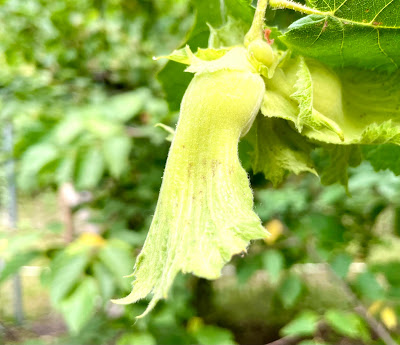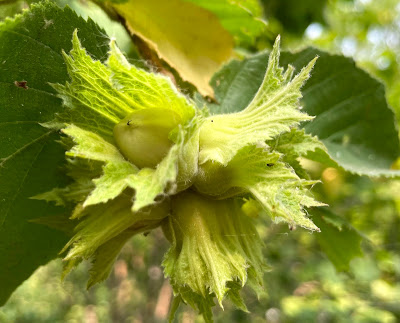Riverbend Hazelnuts
This is my path between 2 hazelnut plots in October. As you can see I fence off all the plots of hazelnuts to keep the deer and rabbits out. The deer will nip off the higher new branches with the catkins (male flowers that develop in the late summer) and the rabbits will chew off the bark on the lower part of the stem. I have not yet found a way to keep the squirrels, mice, and raccoons out, but I'm working on that.

These are the catkins on a American hazelnut that came from Northern Minnesota just a couple miles from the Canadian boarder. They form on the branch in late summer, and if the deer do not remove them they will elongate and expand in the spring and release their pollen to fertilize the female flowers that appear in March. Notice that they are a single catkin held tight to the branch. Some of the hybrids have different types of catkins that may winter damage and never open up and release their pollen. I can always count on these hardy type catkins to deliver pollen in the spring for the whole orchard.
These are catkins on the hybrid hazelnut plants. They have multiple catkins on one stem which are not as hardy as the catkins on the American hazelnut and will sometimes have some winter damage and not shed their pollen. These hybrid plants also produce the largest, best tasting nuts.
When planting hybrid hazelnuts in this area it's best to plant several types to ensure a good pollination every year no matter what type of weather you have in the winter and spring.
The dual catkins on this plant is on a beaked hazelnut, Corylus cornuta.
Knowing what the catkins look like gives some insight as to what type of nut it will produce.
This is the fall color of the hardy American hazelnut in the last week of August.
The last week of September and this American hazelnut has already dropped its leaves.
To help in judging the hybrid plants hardiness I try to note the time the plant drops its leaves.
Here are the fall colors of some of the hybrid hazelnuts in the middle of October.
Most of the hazelnuts that have this very nice orange and red coloring do not produce decent nuts, and I'm hoping some day to have a plant with large nuts and great fall colors.
Evaluating nuts for the fall 2021, I found they are all slightly smaller than last year.
I think this was due to the very dry spring and summer and the fact that I do not irrigate the mature plants.
It was hard just to keep the garden, potted hazelnut plants, and the hazelnut plants I was layering watered.
Another problem was that the Sheyenne river was so low that I had a hard time pumping from the river.
This is the first time in 40 years that I was actually wondering what I would do if the river stop flowing because I could not afford using Cass Rural Water.
I cracked a few of the nuts to show the shell thickness and size of the kernel.
It will also show if the kernel has a pellicle (a thin papery covering of the kernel).
This is a close up of just the hazelnut kernel, and you can now see a pellicle on some of the kernels.
In this picture you can see how the kernel did not fill out the shell. This happens when the nut is picked too early and has not matured enough. These nuts were falling off the tree, so I assume the cause was the drought conditions.
Jason Fischbach's Hazelnut Research Bulletin Dec 1, 2020 had one paragraph that really hit home for me:
"Although the kernels had reached full size in the shell by mid-August and appeared fully formed and mature, looks can be deceiving. It can take another 3 weeks or more for the starch and moisture to replaced by sugars and oil such that the kernels stay fully formed upon drying. If harvested too early, the kernels shrivel and aren't saleable. The general recommendation for hybrid hazelnuts grown in the upper Midwest is to wait for the nuts to abscise and be loose in the husk before harvesting. Understandably, this recommendation is hard to follow while watching blue jays and squirrels make off with the clusters."
Upper Midwest Hazelnut Development Initiative and Jason Fischbach have been doing a great job updating and distribute all the new hazelnut research to anyone interested in growing hazelnuts.
Several plants had these cracked nuts. These were from plants with thin shells and that mature late.
This year we had a very dry spring and summer and then this fall we had a lot of rain, so these plants must have swelled the kernel with excess moisture and cracked the shell that had already hardened.
This is the first time I've ever seem this and it will be interesting trying to process them.
Other nuts in the orchard
There are few different types of nut bearing trees in the hazelnut orchard.
This is a buckeye of which I have a few different types of these inedible nuts. I thought the squirrels would go for these larger nuts instead of the hazelnuts. I found that the squirrels will not touch these nuts until all the hazelnuts are gone.
The black walnut that I planted in 1978 is now 60 feet tall and produces large quantities of nuts. The squirrels do like them, but they still prefer hazelnuts over black walnuts.
This black walnut I grew from seed and planted it in the hazelnut orchard to find out if they affected the growth of the hazelnut plants. So far the only thing I found was that it's starting to shade out some of the hazelnut plants and might have to be removed. It does produce a lot of nuts, but I just haven't required a taste for them yet. During the winter I do snack on them quite a bit. The tough part is cracking the nut.
This is just a small portion of the black walnuts I pick up everyday.
If you look on the ground around the tree you can see the empty shells. I think the squirrels had a party the night before.
Here are few of the black walnuts that I'm drying down for the winter.
That is not some other type of fruit in the picture but a walnut in the husk.
The husk also contains a dye will turn your hands permanently black, so wear a pair of good gloves when removing the husk.
The pecan here has now grown for 2 seasons and made it through our North Dakota winters . In 20 years it might start producing nuts. I received 6 pecan nuts from Derek Jundt in Bismark February 2020 and 5 are still growing.
This tree might be a butternut and it did bloom last year, but as yet it has not produced any nuts.
This tree did have one stem 5 years ago but a buck deer destroyed it and now it's more of a butternut bush until it is pruned back into more of a tree form. Now I've been putting up a wire fence around it every fall.
One interesting thing is that I'm not sure if it is a butternut plant. I ordered 2 butternut plants from a nursery and both are complete different.
This is a branch from that plant from previous picture with 2 main stems.
I do have butternuts that I've grown from seed
and each one is a little different, but this one is completely different.
This is a branch from the second butternut that I purchased. It is not even close to the other plant.
It does closely resembles the butternuts I've grown from seed.
This is a butternut that was grown from seed and it does look very similar to the second tree that I purchased.
Here is the entire butternut tree that was grown from seed.
The next pictures are of branches are from different butternut seeds that I collected and grown from different plants
In doing some research to find out if these are all butternuts, I read that quite a few are hybrid butternuts to increase the hardiness of the common butternut.
They stated that the hybrids are usually crossed with heartnuts.
It will be interesting see what type of nuts these trees will produce.
Identifying a black walnut
When identifying a black walnut I have found that the new growth and leaves have a sticky feeling and the primary and secondary buds are together above where the new leaf connects to the stem.
This is a black walnut right after leaf drop, note the location of the primary and secondary buds above the leaf scar.
In 1980 I bought 2 butternuts from some mail order nursery and when they started producing nuts some 10 or 12 years later I realized they were black walnuts. I was a little upset and cut both down.
This is the result of squirrels planting black walnuts in my back lot for the past 10 years. I'm planning on planting hazelnuts in this area so all but 3 of the black walnuts will be removed.
One interesting thing I noticed is common buckthorn (one of my most hated plants) disappeared almost entirely from this area. I assume the black walnuts must gradually inhibit buckthorn growth.

Instead of removing all these volunteer black walnuts, I've been grafting butternuts on them.
So far three look like they'll make it.
I also have 2 shagbark hickories. They always have such a bright golden fall color every year.
I've read it takes 30 to 40 years to mature and produce nuts.
They are just about 10 years old so in just 20 years it might have nuts.
That's quite a big difference from hazelnuts which take only 3 or 4 years to start producing nuts.
Northern Plains Botanic Garden Society's Edible Forest has 3 of my hybrid hazelnuts that were planted in the fall of 2019. I was surprised to find nuts growing on one of the plants. I did try hand pollinating the plants this spring. With the large numbers of catkins on all 3 plants now, there should be nuts on all 3 plants next year.
I found this interesting that hazelnuts have started growing on the riverbank.
The squirrels must have buried some nuts along the bank. These are mostly American hazelnuts that like to sucker and should cover most of the river bank in a few years. They should make a great riparian buffer zone for wild life and hold the riverbank from eroding.
Some other interesting plants that are not nut trees are this Sea Buckthorn (Hippophae elaeagnaceae).
They are a little invasive and should not be planted in the front yard. Both a male and female plants are needed for fruit production. The berries taste like a sour orange or grape fruit and are high in vitamin C.
These are not to be confused with the common buckthorn (Rhamnus cathartic L.) that I've been trying to eradicate for 40 years.
Another interesting plant is this Trader mulberry that I received from Jim Walla.
It was loaded with fruit this year, but the birds got almost every one and left me with the scraps.
After the rains started this fall, these mushrooms showed up on this ash stump. The orange colored edible mushroom is called chicken of the woods, which is one of my favorite fungi.
This is chicken of the woods fried up and ready for tasting.😛




































































